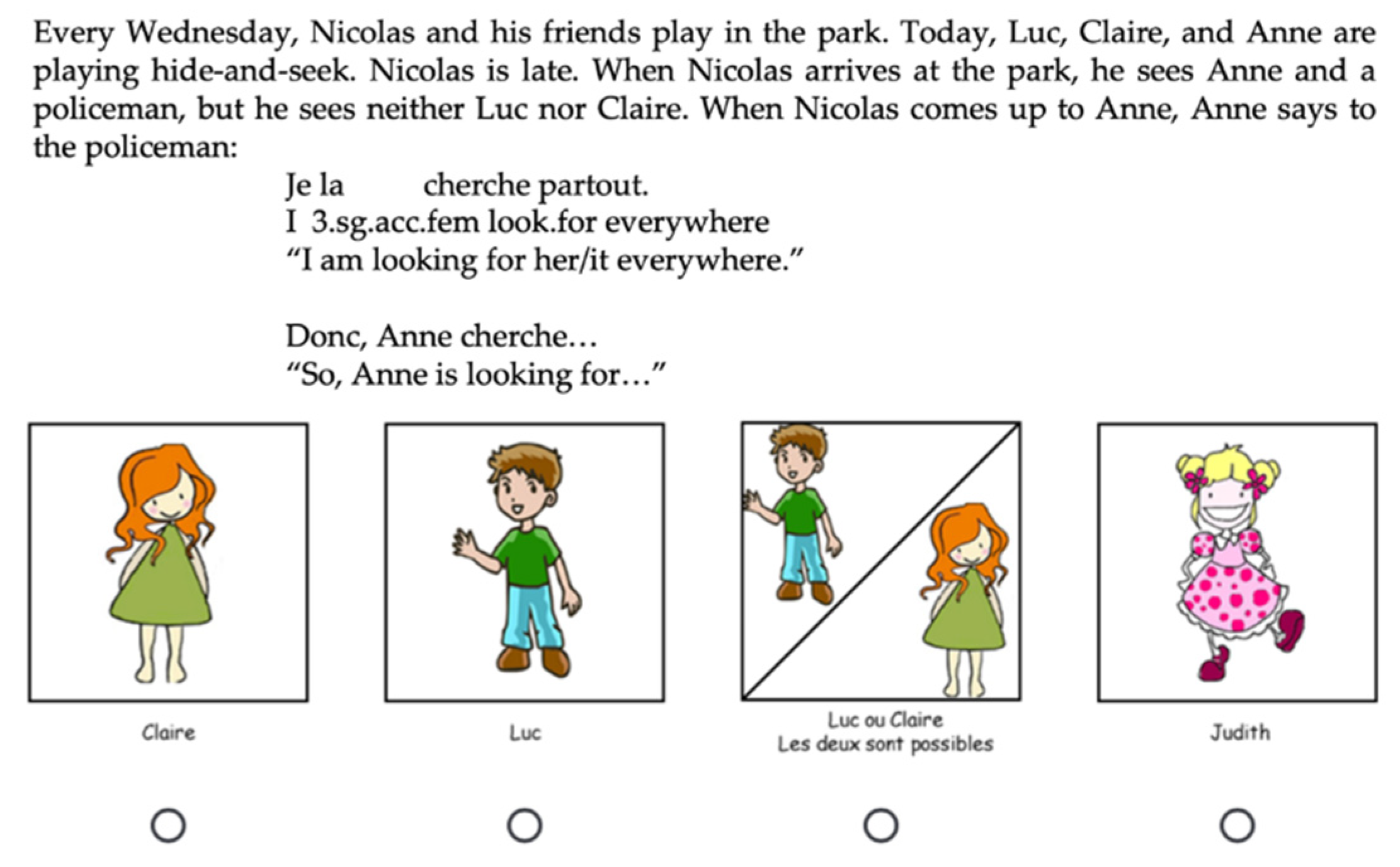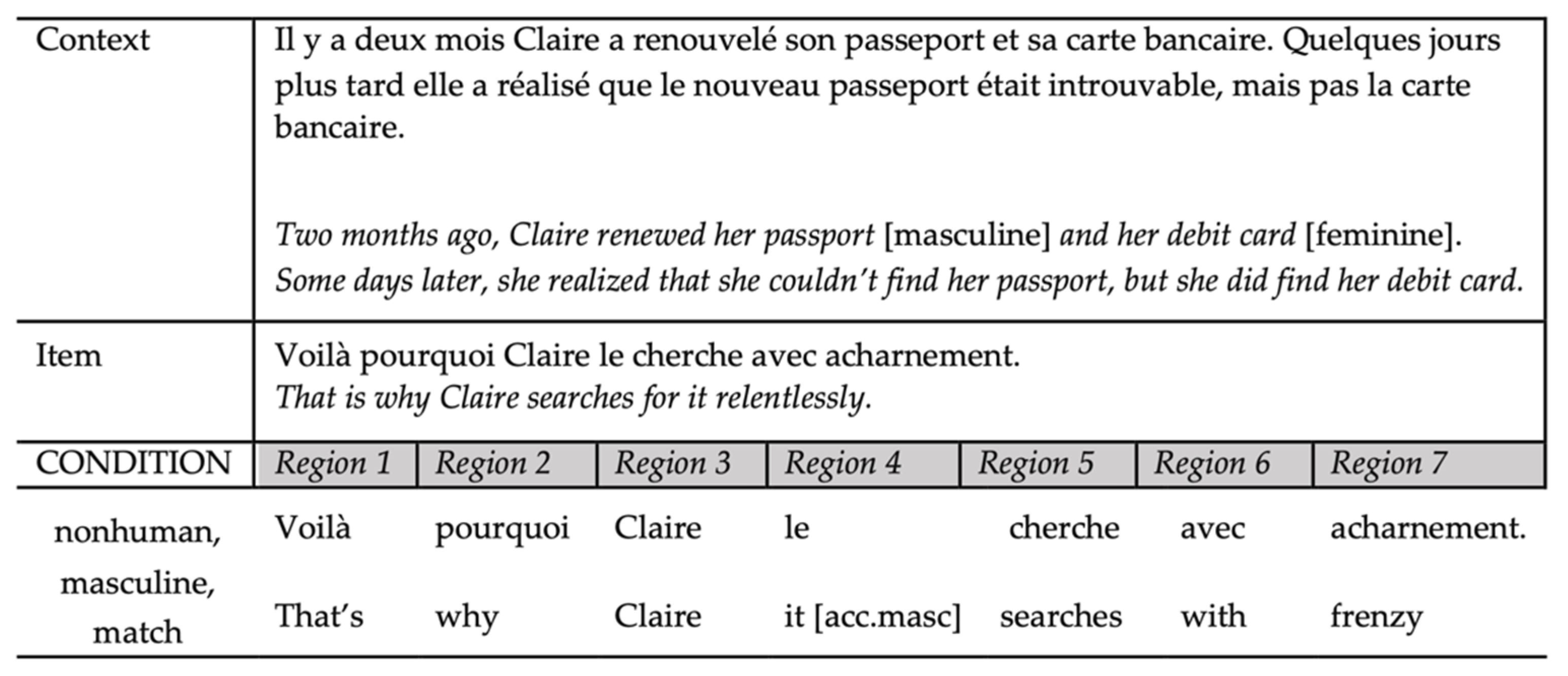1. Introduction
It has long been discussed in the literature on bilingualism/multilingualism that first (L1) and second (L2) languages are interconnected in the mind of a speaker. To explain such relationships, several frameworks have made different proposals. From a usage-based perspective, abundant evidence shows that both languages in a bilingual’s mind remain available and activated when processing both written and spoken language. This parallel activation of the lexicon in both languages has been shown to operate when surface-level similarity exists between isolated words (
Dijkstra et al. 1998;
Marian and Spivey 2003) and between sentence structures (
Baten et al. 2011;
Duyck et al. 2007).
In contrast to usage-based perspectives, generative approaches have traditionally focused on understanding speakers’ underlying knowledge of syntactic and morpho-syntactic properties. Numerous studies conducted within this framework investigate whether knowledge of L1 grammar affects how the L2 is represented and used (the question of ‘L1 transfer’) and whether bilinguals are able to derive the same meanings and arrive at the same linguistic judgments in their L2 as native speakers (NSs).
While usage-based research demonstrates the important role surface-level similarity plays in language acquisition and processing, generative research has provided crucial evidence of the importance of abstract-level phenomena in L2 acquisition and processing. Therefore, one important open question is the role that both abstract-level similarity (e.g., similarity in structural or syntactic function) and surface-level similarity (e.g., similarity in how two forms look or sound) play in the acquisition and use of a second or subsequent (Ln) language. In this study, we investigate how abstract- and surface-level similarity between a speaker’s L1 and L2 affect L2 comprehension and incremental L2/Ln language processing.
We do so by investigating L2 acquisition of French pronominal clitics by NS of Spanish. To the best of our knowledge, no previous study has investigated situations wherein both formal- and surface-level similarities can be established between grammatical forms in two languages. One could, thus, argue that a situation like the one we are considering here constitutes a situation where both usage-based and generative approaches can provide valuable insights into the minds of bilingual speakers.
The rest of the paper is organized as follows: the next section details theoretical background, describes the linguistic property under investigation, and briefly discusses some previous research relevant for the current study. The section ends with the presentation of the research questions. Sections three and four present the two experiments and their results followed by a discussion section and a brief conclusion.
5. General Discussion
As we mentioned at the outset, the goal of our study was two-fold. First, we aimed to determine whether formal similarity between two languages (operationalized via the Feature Reassembly Hypothesis, which is couched in the generative tradition) would allow adult L2 learners of French (Spanish NSs) to straightforwardly acquire third-person singular accusative clitics in their L2 (RQ1). We focused on Spanish-French bilinguals because, in terms of formal similarity, both languages encode the same features in analogous ways regarding accusative clitics. Additionally, following insights from usage-based research on bilinguals, we tried to determine the role played by surface similarity because French and Spanish overlap and diverge in interesting ways; we also aimed to determine whether the difference in the actual form of the masculine (but not feminine) clitics could affect results (RQ2).
To answer these questions, we used an offline picture selection task and an online self-paced reading task. The results of both tasks showed that, although French and Spanish encode features in similar ways, Spanish-French bilinguals evinced non-trivial difficulties in their interpretation and processing of French accusative clitics. With regard to our research questions, the data from both tasks showed that the answer to RQ1 was negative: Although there was nothing to reassemble, the acquisition of these clitics did not proceed straightforwardly, against the predictions of the Feature Reassembly Hypothesis.
The picture selection task showed that the overall accuracy of the learners was relatively low (64.57% overall, compared to 96.86% for the L1 group), while also showing that learners were more accurate with feminine clitics, but only where these were [+human]. Alternatively, learners were more accurate with [+human] referents, but only when these were feminine. This result lends partial support to the notion that surface-level similarity may play a role, since the feminine clitics share the same form in both languages (“la” [la]), while the masculine clitics differ both in written form and sound (“le” [lǝ] French, “lo” [lo] in Spanish). Additionally, we did observe proficiency effects over overall accuracy, which means the developmental trajectory is positive.
The results of the self-paced reading task also showed that learners did not process accusative clitics in the same way as natives, and this difference was not only quantitative. Although the learners evinced a delayed effect, compared to NSs, they were also influenced by the gender of the clitic and whether the referent was [±Human] such that they made a distinction between [+human] and [−human] referents within the matched conditions but also for both masculine and feminine referents. The native French speakers’ processing of these clitics, however, was not guided by either gender or the feature [±Human] because the only relevant distinction was between (gender-) matched or mismatched referents. These results again challenge the Feature Reassembly Hypothesis, although they do not offer unequivocal support to the notion that surface-level similarity matters: This issue was present in both the feminine and masculine conditions.
Together, the results from both experiments showed that Feature Reassembly is not the only factor in the acquisition of object clitics: Even when there is no need for reassembly, that does not entail convergence (RQ1). In terms of surface-level similarity (RQ2), we have partial support from our offline task that there might be a facilitatory effect when formal and surface-level similarity coincide. However, our investigation does leave several open questions, the most pressing of which is perhaps this: Given the overwhelming similarity between French and Spanish feminine accusative clitics, why do we not observe convergence?
One interesting feature of both participant groups is their degree of multilingualism. As shown earlier, all participants, irrespective of group, reported learning English. This is not surprising because in Mexico, exposure to English is, at least nominally, compulsory under a program known as
El Programa Nacional de Inglés (National English Program) sponsored by the Ministry of Mexican Public Education (
Secretaría de Educación Pública). In practice, however, Spanish-English bilingualism is far from universal. This is relevant because, as mentioned in the introduction, English differs from both Spanish and French in terms of encoding the [±Human] feature, since the pronominal system does encode [±Human] (e.g.,
he/she vs.
it). Previous research with Anglophone learners of French revealed differences in reading time patterns depending on the value of the [±Human] feature (
Shimanskaya and Slabakova 2017). Thus, we cannot rule out that the L2 learner group could be influenced by the other languages in their repertory. This would necessitate, however, that they had actually acquired the English pronominal system, which is far from an easy task. Given the ubiquity of English as an L2 in Mexico, future research should control for learners’ knowledge of the English pronominal system.
An additional open question from the picture selection task is the higher accuracy rates with feminine referents, especially when these are [+human]. We noted earlier the potential role of surface-level similarity, but there might be additional explanations. Recall that, in terms of gender, French NPs bear a gender feature that can be specified as [feminine] or else left unspecified, which means it receives a [masculine] valuation by default. This means that [feminine] values are contingent on it being distinguished by the feature [Gender]. [Masculine], on the other hand, does not have to be individuated because it is not assumed to be represented in the feature matrices. Thus, it is possible that the lower accuracy with masculine clitics is related to its underspecification of gender [Gender: ∅]. Given our particular language combination, this is a possibility we cannot discard.
We noted that researchers such as
Hopp (
2013) have proposed that lexical knowledge of gender might be distinguished from how gender is processed online. In theory, then, this could constitute an explanation for our results. In our materials, we did not match the gender of the referents because the gender was unambiguously marked in the determiner in the context for both tasks. Moreover, after examining our materials, we note that most NPs were of the same gender in both languages. In the SPR, only six referents (out of the 48 introduced) did not match in gender: With one exception (
grille-pan [masc.French],
tostadora [fem.Spanish] “toaster”), these referents were all feminine in French but masculine in Spanish. In the picture selection task, only two of the referents (
le paplemousse “the grapefruit”,
le sac à dos “the backpack”) were not matched, since they were masculine in French but feminine in Spanish (
la toronja “the grapefruit”,
la mochila “the backpack”). Thus, even if learners had missed the gender in the context, this is an unlikely explanation for our results.
No study is without limitations, and ours is no exception. As mentioned earlier, our study was very long overall (almost two hours of testing), and we tried to shorten the duration by including shorter test sentences in the SPR. This meant the delayed effects occurred in the last region, which is not typically analyzed because wrap-up effects are not well understood (
Just et al. 1982). We will note, however, that we are not the first to analyze this region (
Tokowicz and Warren 2010); moreover, our data (
Figure 4 and
Figure 5) show that the effects were quite delayed, which is not surprising because our regions were very small, often including a single word. Future research should take this into account by ensuring that sentences have a sufficient number of regions after the critical one.











